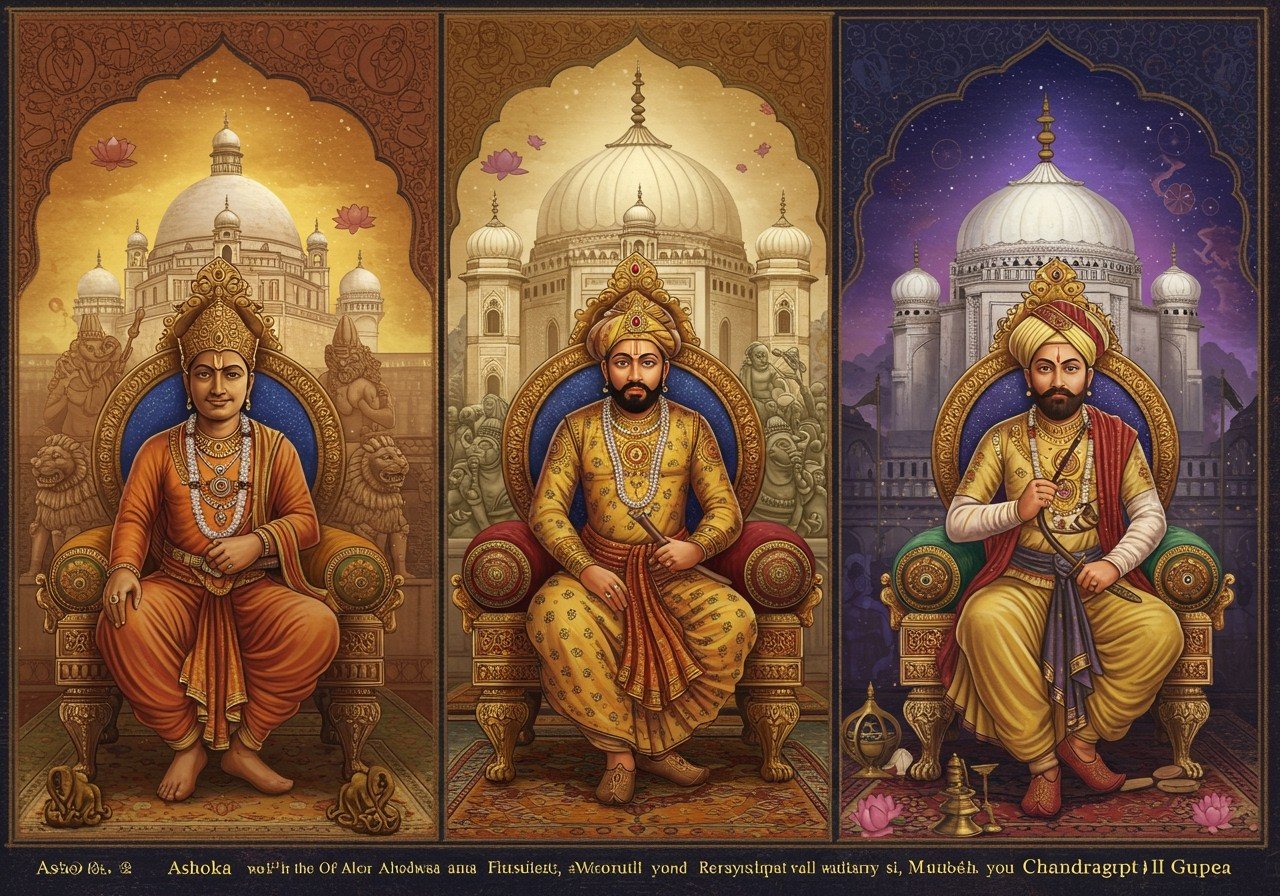
The Mauryan, Gupta, and Mughal dynasties stand as pillars of Indian history. Each left an indelible mark on India’s cultural, political, and economic landscape. Understanding these dynasties provides insights into India’s rich heritage and the evolution of its civilization.
The Mauryan Empire (321-185 BCE)
Foundation and Leadership
Founded by Chandragupta Maurya in 321 BCE, the Mauryan Empire benefited immensely from the guidance of his advisor, Chanakya. The empire reached its zenith under Emperor Ashoka, whose transformation after the Kalinga War (circa 262 BCE) led him to embrace Buddhism and champion non-violence. This shift significantly influenced the empire’s governance and social fabric.
Administration and Infrastructure
A highly centralized administrative system characterized the Mauryan Empire. A complex bureaucracy ensured efficient governance across the vast territory. An extensive road network facilitated communication and trade, while an early postal system enabled swift message delivery throughout the empire.
Art, Architecture, and Economy
The Mauryan era is renowned for its iconic Ashokan pillars and stupas, reflecting the empire’s artistic and architectural prowess. The economy, primarily agrarian, thrived on trade, extending to international commerce with regions like Greece and Southeast Asia.
The Gupta Empire (320-550 CE)
Foundation and Leadership
Founded by Sri Gupta around 320 CE, the Gupta Empire is often hailed as India’s Golden Age. Key rulers like Chandragupta I, Samudragupta, and Chandragupta II (Vikramaditya) contributed to the empire’s prosperity and cultural efflorescence.
Administration and Governance
Unlike the Mauryans, the Gupta administrative system was decentralized, empowering local governance. This period witnessed a flourishing of classical Sanskrit literature, with luminaries like Kalidasa and Aryabhata making significant contributions to drama and mathematics, respectively.
Cultural Revival and Economy
The Gupta era marked a resurgence of Hinduism, profoundly influencing art, culture, and religious practices. The economy prospered through agriculture, trade, and a sophisticated monetary system.
The Mughal Empire (1526-1857 CE)
Foundation and Leadership
Established by Babur in 1526, the Mughal Empire reached its pinnacle under Akbar the Great. Akbar’s reign is celebrated for his policies of religious tolerance and the implementation of a robust centralized administrative system.
Cultural and Architectural Achievements
The Mughal period is synonymous with architectural splendor. Iconic structures like the Taj Mahal, Red Fort, and Fatehpur Sikri exemplify the empire’s artistic and engineering brilliance. Mughal art, a synthesis of Persian and Indian traditions, created a unique aesthetic legacy.
Economy and Decline
The Mughal economy, built on agricultural wealth, benefited from extensive trade networks and a flourishing textile industry. The empire’s decline began in the 18th century, precipitated by internal conflicts, European colonial ambitions, and the rise of the Maratha Empire.
Comparing Administrative Systems, Cultural Influences, and Economic Contributions
The Mauryan Empire’s centralized bureaucracy ensured efficient governance, while the Gupta Empire’s decentralized structure allowed regional autonomy. The Mughal Empire, under Akbar, sought a balance between central authority and local administration.
Religiously, the Mauryan Empire saw the spread of Buddhism under Ashoka. The Gupta era witnessed a Hindu revival, while the Mughals, particularly under Akbar, promoted religious tolerance.
Agriculture formed the economic backbone of all three empires. The Mauryans and Guptas engaged in extensive trade, while the Mughals fostered a thriving textile industry alongside agricultural production.
Connect with India’s Heritage through Poojn.in
Poojn.in, India’s leading online store for cultural and religious goods, offers a wide selection of products that connect you with India’s rich spiritual heritage. Explore our collection:
- Traditional Puja Items: Discover handcrafted idols and puja essentials reminiscent of those used during these historical periods. Experience the essence of ancient rituals with our authentic collection.
- Sacred Texts and Books: Delve deeper into the spiritual and philosophical beliefs of the Mauryan, Gupta, and Mughal eras with our curated selection of sacred texts and historical accounts. Expand your knowledge and understanding of India’s rich religious heritage.
- Ritual Accessories: Enhance your puja experience with our range of traditional accessories, including incense holders, diyas, and ceremonial items. Create an ambiance of reverence and connect with the spiritual practices of ancient India.
Poojn.in provides high-quality, authentic products that honor India’s rich traditions. Visit our website today to explore our complete collection and bring a piece of history into your home.


